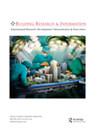Digital workflow for climate resilient building façade generation
IF 3.7
3区 工程技术
Q1 CONSTRUCTION & BUILDING TECHNOLOGY
引用次数: 0
Abstract
ABSTRACT The contribution presents the results of an applied research aimed at developing an operative methodology and its corresponding data-driven and user-friendly computational workflow for the design of climate-resilient building façade (CRBF) able to adapt to the variation of the environmental conditions through morphology configuration. The research consists of an expansion of an already defined computational workflow proposed to design performance-based architectures and applicable in the early stage of the design process. As far as the façade design is concerned, the contribution foresees to obtain a series of intermediate objectives that contribute to the achievement of optimized design solutions for unitized multifunctional façades which presents different benchmark parameters in relation to the specific design phase and the climate zones in which the façade can be located. The research proposes a case study located in Abu Dhabi (sub-tropical, arid climate) to explore the relationship described above. The research was carried out in two consequential phases, early-stage and mid-stage, involving various benchmarks and different optimization processes that all together describe the complexity of building façade. The design of modular and parametrically façade demonstrates the reliability of the proposed methodology in ensuring benchmarks achieving and optimizing performative aspects, defined according to site's climate analysis.用于气候适应性建筑立面生成的数字工作流程
摘要:本文介绍了一项应用研究的结果,该研究旨在开发一种操作方法及其相应的数据驱动和用户友好的计算工作流,用于设计能够通过形态配置适应环境条件变化的气候适应型建筑立面(CRBF)。该研究包括对已经定义的计算工作流的扩展,该工作流提出用于设计基于性能的体系结构,并适用于设计过程的早期阶段。就立面设计而言,该贡献预计将获得一系列中间目标,这些目标有助于实现针对统一多功能立面的优化设计解决方案,这些设计方案根据具体设计阶段和立面所在的气候带提供不同的基准参数。该研究提出了一个位于阿布扎比(亚热带干旱气候)的案例研究,以探索上述关系。研究分早期和中期两个阶段进行,涉及各种基准和不同的优化过程,这些过程共同描述了建筑立面的复杂性。模块化和参数化farade的设计证明了所提出的方法在确保基准实现和优化性能方面的可靠性,根据场地的气候分析进行定义。
本文章由计算机程序翻译,如有差异,请以英文原文为准。
求助全文
约1分钟内获得全文
求助全文
来源期刊

Building Research and Information
工程技术-结构与建筑技术
CiteScore
8.60
自引率
7.70%
发文量
43
审稿时长
>12 weeks
期刊介绍:
BUILDING RESEARCH & INFORMATION (BRI) is a leading international refereed journal focussed on buildings and their supporting systems. Unique to BRI is a focus on a holistic, transdisciplinary approach to buildings and the complexity of issues involving the built environment with other systems over the course of their life: planning, briefing, design, construction, occupation and use, property exchange and evaluation, maintenance, alteration and end of life. Published articles provide conceptual and evidence-based approaches which reflect the complexity and linkages between cultural, environmental, economic, social, organisational, quality of life, health, well-being, design and engineering of the built environment.
 求助内容:
求助内容: 应助结果提醒方式:
应助结果提醒方式:


